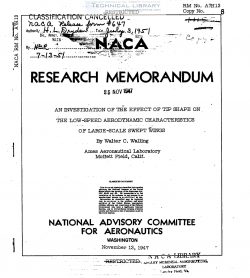naca-rm-a7h13
- Version
- 108 Downloads
- 586.07 KB File Size
- 1 File Count
- April 20, 2017 Create Date
- April 20, 2017 Last Updated
An Investigation of the Effect of Tip Shape on the Low-Speed Aerodynamic Characteristics of Large Scale Swept Wings

In an effort to remedy some of the undesirable pitching-moment
characteristics of swept wings with relatively high aspect ratios
and to improve the maximum lift coefficient obtainable, an investi—
gation has been made of the effect of tip shape on the aerodynamic
characteristics of large—scale 15° swept—forward. and 45° swept—back
wings. Also toward this end, the swept—back wing was tested with
bodies of revolution, with and without ducts, mounted. on the tips.
'Jhe results show that none of the variations of tip shape
investigated nor addition of bodies of revolution at the tips
produced major changes in the characteristics of the swept wingse
Tips cut off oblique to the air stream exhibited slightly better
pitching—mment characteristics at high angles of attack for the
swept—forward. and swept-back wings. Taft studies indicated that
unstable pitching-moment characteristics of swept—back wings at
high angles of attack are caused by a rapid development of leading—
edge stall, beginning at the tip and progressing inboardo
In order to capitalize on the high-speed advantages of highly
swept wings, it is necessary that several low-speed problems be
solved. Two of the more troublesome of these problems are (1) poor
pitching—moment characteristics of wings with relatively high
aspect ratios involving a sharp increase in stability at moderate
angles of attack followed by marked instability at higher angles,
and. (2) low value of maximun lift.
On the basis of_examination of pressure—distribution measure—
ments and tuft obseflations on swept wings, it was thought that
variation of tip shape from the conventional design (outboard. edges
nearly parallel to the air stream) might favorably alter these
undesirable characteristics. Therefore, four pairs of tips, represent-
ing wide variations of -lape, were tested on 15° swept—forward and
swept—back large—scale wings.
In addition to the foregoing, studies were made of the effect
of bodies of revolution mounted at the tip of the swept-back wing.
Since the-boundary layer of swapt—back wings flows outward, accu-
mulating at the tips and precipitating early tip stall, it was
heped that the low—pressure field surrounding the unducted bodies
would create a suction powerful enough to draw off the accumulated
boundary layer.
| File | Action |
|---|---|
| naca-rm-a7h13 An Investigation of the Effect of Tip Shape on the Low-Speed Aerodynamic Characteristics of.pdf | Download |

Comment On This Post